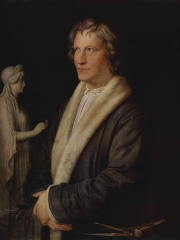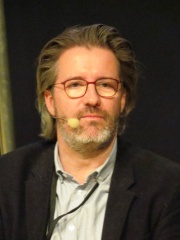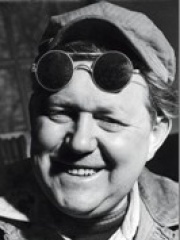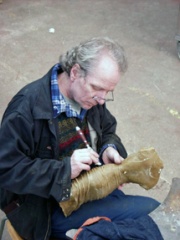



The Most Famous
SCULPTORS from Denmark
This page contains a list of the greatest Danish Sculptors. The pantheon dataset contains 258 Sculptors, 4 of which were born in Denmark. This makes Denmark the birth place of the 15th most number of Sculptors behind Netherlands, and Sweden.
Top 4
The following people are considered by Pantheon to be the most legendary Danish Sculptors of all time. This list of famous Danish Sculptors is sorted by HPI (Historical Popularity Index), a metric that aggregates information on a biography's online popularity.

1. Bertel Thorvaldsen (1770 - 1844)
With an HPI of 74.22, Bertel Thorvaldsen is the most famous Danish Sculptor. His biography has been translated into 49 different languages on wikipedia.
Albert Bertel Thorvaldsen (Danish: [ˈpɛɐ̯tl̩ ˈtsʰɒːˌvælˀsn̩]; sometimes given as Thorwaldsen; 19 November 1770 – 24 March 1844) was a Danish-Icelandic sculptor and medalist of international fame, who spent most of his life (1797–1838) in Italy. Thorvaldsen was born in Copenhagen into a working-class Danish/Icelandic family, and was accepted to the Royal Danish Academy of Art at the age of eleven. Working part-time with his father, who was a wood carver, Thorvaldsen won many honors and medals at the academy. He was awarded a stipend to travel to Rome and continue his education. In Rome, Thorvaldsen made a name for himself as a sculptor. Maintaining a large workshop in the city, he worked in a heroic neo-classicist style. His patrons resided all over Europe. Upon his return to Denmark in 1838, Thorvaldsen was received as a national hero. The Thorvaldsen Museum was erected to house his works next to Christiansborg Palace. Thorvaldsen is buried within the courtyard of the museum. In his time, he was seen as the successor of master sculptor Antonio Canova. Among his more famous public monuments are the statues of Nicolaus Copernicus and Józef Poniatowski in Warsaw; the statue of Maximilian I in Munich; and the tomb monument of Pope Pius VII, the only work by a non-Catholic in St. Peter's Basilica.

2. Olafur Eliasson (b. 1967)
With an HPI of 60.26, Olafur Eliasson is the 2nd most famous Danish Sculptor. His biography has been translated into 34 different languages.
Olafur Eliasson (Icelandic: Ólafur Elíasson; born 5 February 1967) is an Icelandic–Danish artist known for sculptured and large-scaled installation art employing elemental materials such as light, water, and air temperature to enhance the viewer's experience. In 1995, Olafur established Studio Olafur Eliasson in Berlin, a laboratory for spatial research. In 2014, Olafur and his long-time collaborator – German architect Sebastian Behmann – founded Studio Other Spaces, an office for architecture and art. Olafur represented Denmark at the 50th Venice Biennale in 2003 and later that year installed The Weather Project, which has been described as "a milestone in contemporary art", in the Turbine Hall of Tate Modern, London. Olafur has engaged in a number of public projects, including the intervention Green river, carried out in various cities between 1998 and 2001; the Serpentine Gallery Pavilion 2007, London, a temporary pavilion designed with the Norwegian architect Kjetil Trædal Thorsen; and The New York City Waterfalls, commissioned by Public Art Fund in 2008. Olafur also created the Breakthrough Prize trophy. Like much of his work, the sculpture explores the common ground between art and science. It is molded into the shape of a toroid, recalling natural forms found from black holes and galaxies to seashells and coils of DNA. Olafur was a professor at the Berlin University of the Arts from 2009 to 2014 and has been an adjunct professor at the Alle School of Fine Arts and Design in Addis Ababa since 2014. His studio is based in Berlin, Germany.

3. Robert Jacobsen (1912 - 1993)
With an HPI of 58.13, Robert Jacobsen is the 3rd most famous Danish Sculptor. Her biography has been translated into 17 different languages.
Robert Julius Tommy Jacobsen (4 June 1912 – 26 January 1993) was a Danish sculptor and painter. The Danish Robert Award is named in his honor.

4. Jens Galschiøt (b. 1954)
With an HPI of 51.88, Jens Galschiøt is the 4th most famous Danish Sculptor. His biography has been translated into 18 different languages.
Jens Galschiøt (born 4 June 1954) is a Danish sculptor best known for the Pillar of Shame. Galschiøt moved to Odense in 1973, and in 1985 he opened a 2,000-square-metre (22,000 sq ft) combined foundry, studio, Gallery Galschiøt and sculpture park. In 1990, Galschiøt, Erik Mortensen and Jean Voigt, created the sculpture The Ringwearer's Jacket, which was commissioned by the Clothing Industry's Union of Denmark for Queen Margrethe II’s 50th birthday. Galschiøt contributed work to the Seville Expo '92. Jens Galschiot is a complex artist whose work incorporates elements of installation art, conceptual art, happening, performance art, and Street Art with clear references to "social sculptures" (Joseph Beuys), Symbolism and Art Nouveau. Jens Galschiot mainly works with sculptures to fight the injustice in the world, and puts them up in big squares and cities all around the world. The sculptures are mainly made in bronze and paid for with his own money. In 1997, he created the Pillar of Shame in Hong Kong. This became the start of a series of sculptures with the same name when he created a second in Mexico in 1999 and a third in Brazil in 2000. In 2008, Galschiøt started The Color Orange campaign against alleged violations of human rights in China. He was denied entry to Hong Kong, where he had intended to paint the Pillar of Shame orange.
People
Pantheon has 4 people classified as Danish sculptors born between 1770 and 1967. Of these 4, 2 (50.00%) of them are still alive today. The most famous living Danish sculptors include Olafur Eliasson, and Jens Galschiøt. The most famous deceased Danish sculptors include Bertel Thorvaldsen, and Robert Jacobsen.

